In Angoulême in France there is a gigantic comic book convention every year. It has been 15 years since I last attended, and this year was the year I returned. The festival is huge, around 200,000 attending guests. If you do not book a hotel for next year, the day you are leving, you are not able to find a room anywhere within a 5 kilometers radius. The guys at the studio had a solution for that since we didn’t book anything… We rented a whole house. Traviling with 7 other artists is a fantastic thing. Everything you talk about is artwork, and other artists and you constantly share thoughts and idols and gets exposed to art you never would have looked into yourself, just because your friend seems so enthusiatic about something or someone.
 |
| A lot of time is spent looking through the art books we bought. |
Before going, I already made different agreements to meet up with artists that I liked and that I have been a fan of for a long time. The french comic book scene is fantastic and sparks very personal artists. But even if I planned for a lot of the things, you can still have a big surprise. I was walking along the line of small publishers with very narrow publications, when suddenly there was a big crowd blocking my view. I squeezed in and saw this little Korean guy doing drawings in a thick book. The drawing was upside down so i did not recognize the style immediately, but when the guys next to me moved I read the sign: Kim Jung Gi.
The guy I had seen on the internet and had dismissed as being something between a fraud and a guy with autism. I almost felt sorry for the guy: When I saw the movie clips I was convinced that something was wrong with him in the head. Surely, no one could do what he does without something being totally wrong. In telling my self this, I once again established order in my universe, because undoubtly Kim Jung Gi was able to do somthing extraordinary.
I was standing in the crowd watching him draw for an hour or so searching for that strange giveaway that he was mentally ill or that somthing that would explain the unexplainable, but nothing happened! He was smiling and laughing, speaking charmingly with his translator and publisher and all the while sketching marvelous drawings for people, with a brush pen in the first page of his sketchbook . I got ice cold. There was nothing wrong with him. My universe crashed again. It looked like he had broken a secret code to drawing, a code that I didn´t even know existed. I decided I had to get to the bottom of this, so I miraculously got an apointment to do an interview with Kim Jung Gi the next day. We met at a bar and through a translater I was able to ask him some questions, and discovered just how incredible an artsit he is, a Super Artist! Like nothing I have ever seen.
JE:
How did you train to be so good at drawing everything? Seems like you have no limits.
KMG:
The difference between me and most other artist is that other artist try to draw things from looking at reference and copying what they see. I try to look at live objects and study them in front of me. I draw from real life. By doing that I become more capable of remembering them afterwards.
Ever since I was little, when I watched movies I would go back in my mind and draw what I remembered and what I liked from the movie, as an interpretation of the movie or a comment, if you like.
I have a very good memory.
JE:
So the training functions as a visual vocabulary?
Is this why you do not need pencil lines beneath your inked drawings?
KMG:
Yes, I use memories as reference.
The thing about not using a sketch before drawing has another explanation. I run a private school as a pre-academy for those who want to go to art academy. As a teacher I have to show the students how to draw, but the sketching and colouring took too long, so I tried skipping that stage to be more flexible, and it worked.
JE:
Whoah. When did you begin skipping that step. At what point?
KMG:
It was in first grade in university when I became more and more confident in my drawing skills. When I felt free, and convinced that I had reached that level.
JE:
All this training, I mean your sketchbook is filled with all these sketches of people and vehicles. To me sketching is like bodybuilding and training. Do you train for a specific project? Is there a special aim, something you really want to do? Is there a specific dream? I ask, not to sound rude or anything, I love the sketches; I am just curious as to what you will do with all that skill?
When I saw the big brush-drawing you did at the drawing show today, I noticed it had multiple animal figures, very narrative and with great expressions. But when I look at the sketch book it has many more ‘ordinary’ figures from real life. Girls waiting for a bus, people sitting in a car, spectators at a sports show, and so on. Why continue the training, the sketching, when you can do the other kind of drawing all the time, if you’d like?
KMG:
Do you mean why I continue training at all?
JE:
Yes, training day is over, if you ask me.
KMG:
It is not training to me, it is relaxing and just something that I do; all the time. And it has been that way since I was little. I draw things that interest me for the moment. I add things that spark my interest and just fill the paper. I do it for the process rather than the actual drawing.
(To explain to me, he drags out a sketchbook, the one he is currently using, and lets me skip through it while pointing out specific drawings. I stop at a sketch by an other artist, one of my favourites: Terada Katsuya, It is a drawing of the Monkey King, and next to it is one of Kim Jung GI´s drawing also of a monkey king, but way different. )
I did this Moneky King as an inspired drawing from Terada´s. it is a way of interpret what I see and what is around me. After being at the sea side of Southern France I drew a drawing of the beach scene, but instead of copying what was directly in front of me I drew the memory of it.
If I become interested in things I draw them as an interpretation.
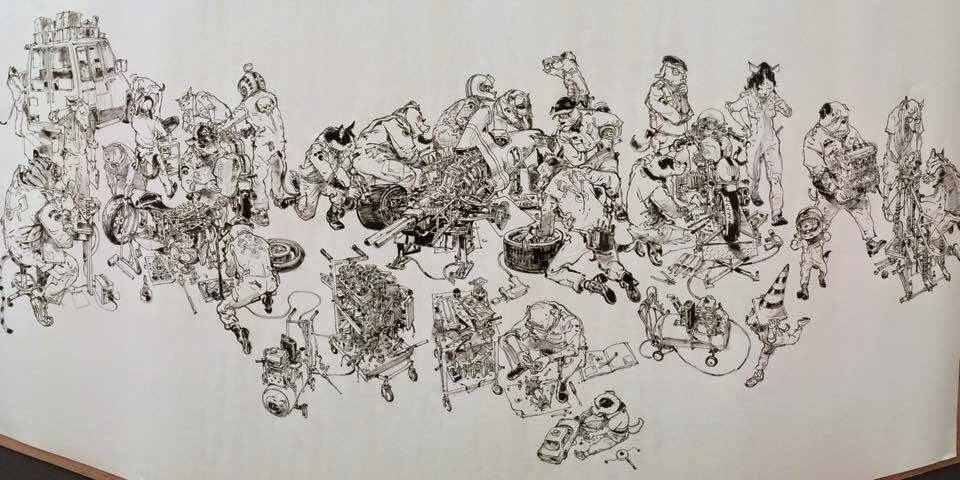 |
| Final from the drawing Show. |
JE:
Well, every artist struggle at something. What are your struggles? If anything? Seems like the female anatomy is not an issue for you.
KMG:
What I struggle with is, that I do not want to be the artist who is behind the trend. I do not like to be the one who gets stuck somewhere. So I always try to be around and involved with other artists, to see what they are doing.
JE:
When you are doing a drawing, do you see the drawing before hand? Do you know what you want to do or do you let the drawing take you where it wants to go?
Do you see the complete drawing in you mind before you start or spontaneously go where it leads you?
KMG:
It depends; there are moments where it is spontaneous. For the drawing show here in Angoulême, I thought: Europeans are very much into cars so I thought I would do a bunch of cars being pulled apart by animals. The audience would like that.
JE:
What are your inspirations? Do you like European artists or mainly look at Asian artists? Basically, where do you find your inspirations?
KMG:
I am inspired by everything.
JE:
Yeah; I kind of figured that.
KM:
But for the moment I use Facebook a lot. There are so many artists there, and what I concentrate on is stuff that I like. I collect everything; paintings, sculptures, music and fashion. As an example, I looked a lot at the latest Prada line to see if there was something I could use for my work. I do not focus on specific style. More the experience. I collect everything even if it looks pointless.
JE:
Thanks for spending time with me, Kim, it has been a pleasure.
(At this point he spoke the only English words during out conversations. Words I will treasure for a long time )
KMJ:
“You are welcome. You are a very cool artist.”
JE:
I am honored. You have given me a whole new look on what it is to be an artist, and I think I need to change pace now and start sketching some more. (We both laugh, me a little forced, since I know that it is 25 years too late to start to become Ejsing Jung Gi.)
Anyways; I walked straight to an artstore and bought a brush pen and a sketch book. Better to start now than later.
www.kimjunggi.net


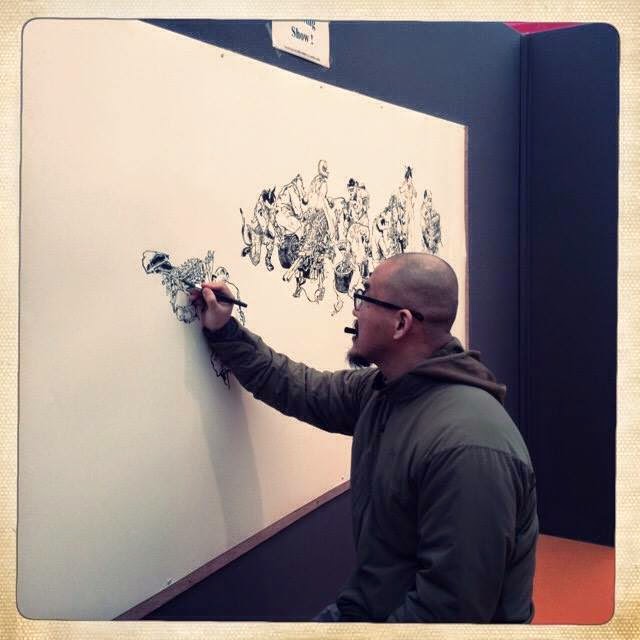
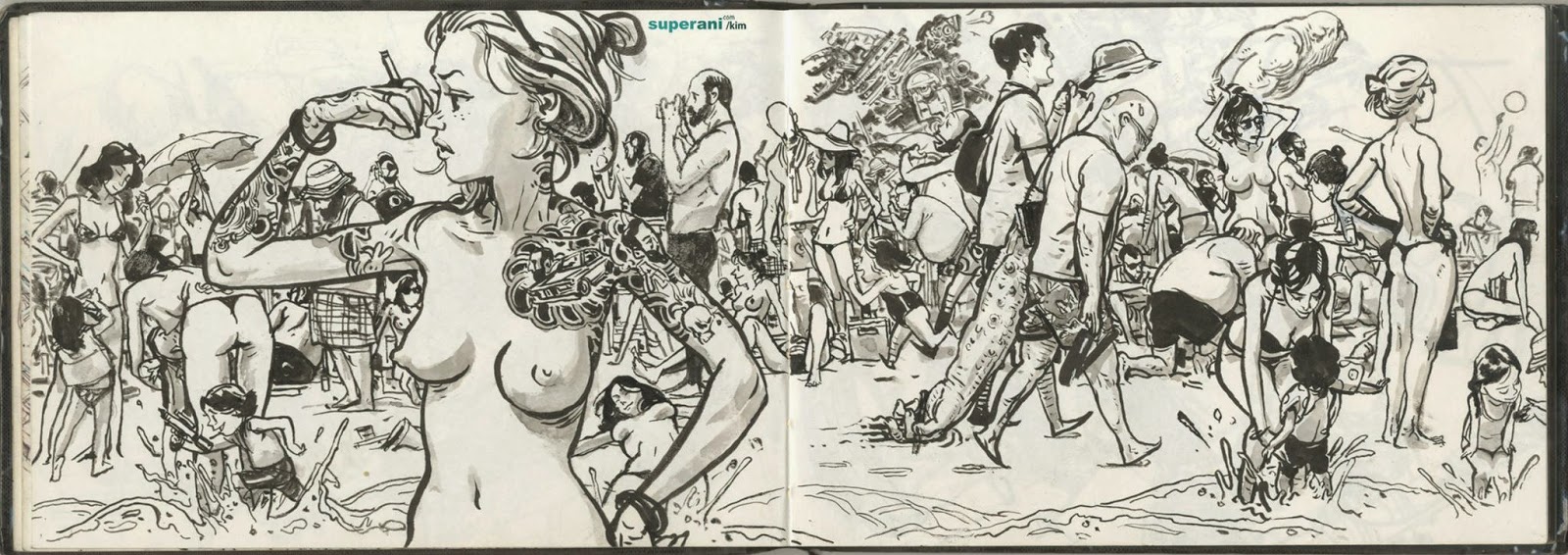
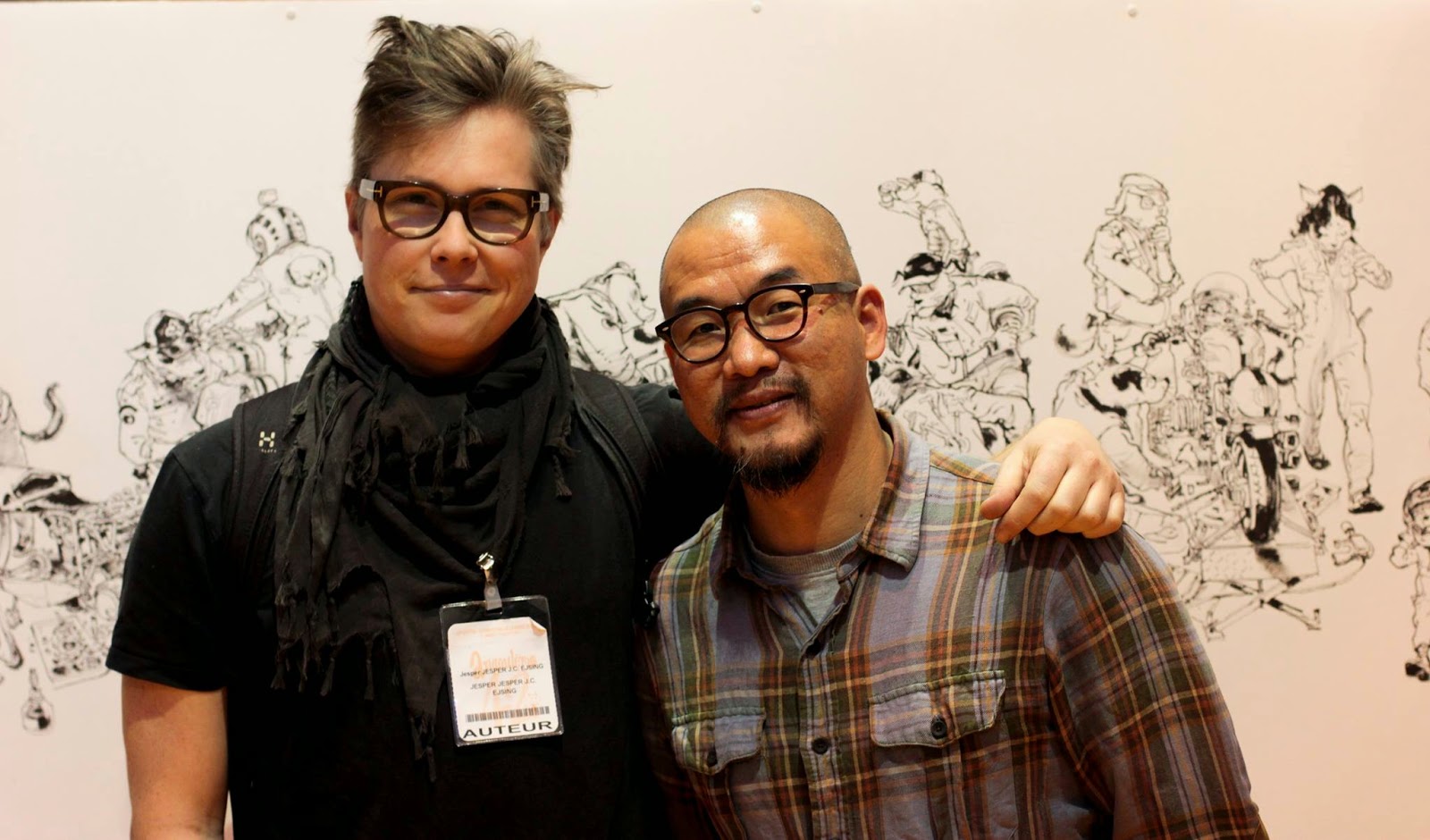
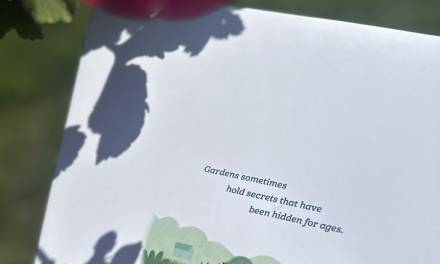
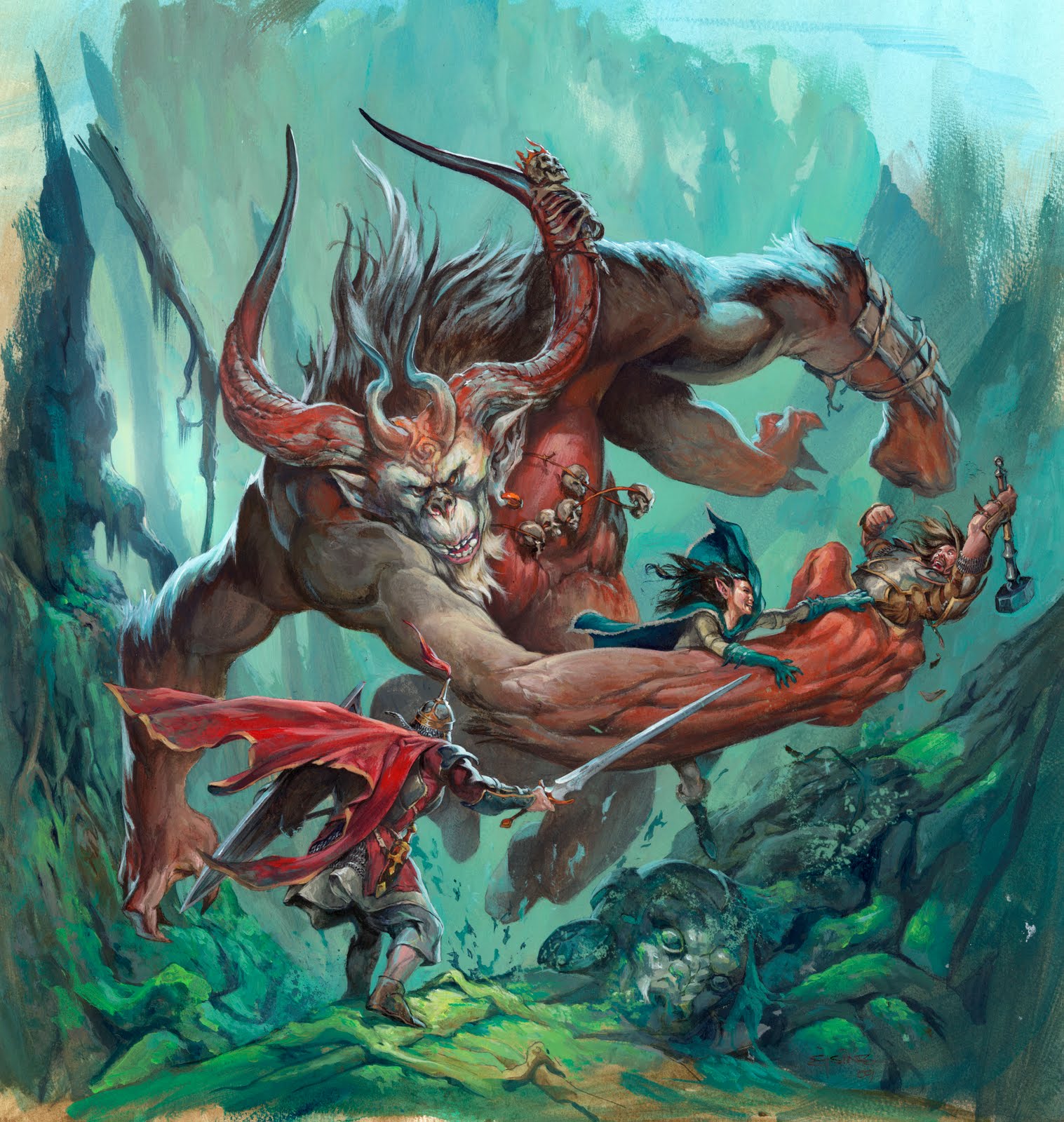

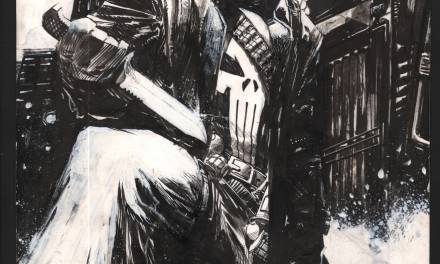

Im filling a third sketchbook … because of this guy .And by that time you start to realize , you will need at least 300 more sketchbooks ,to scratch the surface of his skill .(the guy is a monster in what he does) What i really what to see from him is some old drawings ,to be able to believe that he was once a human 😀 if there ever was such a period in his life …..
“Ejsing Jung Gi” made me laugh. Great interview, thanks for posting, Jesper!
I was always wondering if he has a photographic memory.
What a great opportunity to witness and interview Kim Jung Gi. A super artist indeed! There are some people *cough* Greg Manchess *cough*, that minimize the idea of talent or genius in art. While this is true in most cases, surely Jung Gi is “gifted” with brain wiring that most of us simply do not have. I'm sure he has put forth tremendous effort to achieve his skill level. And yet, very few artists could do the sort of stream-of-consciousness drawing from memory that he does, no matter how much training or hours spent in practice. 😉
Fantastic, Jesper! Thanks!
I still can't fathom how he does that. I mean even with Heinrich Kley you can see his thoughts in snippets of line protruding out. It's just mind boggling! Thank you, Jesper!
Also, I need to remember to select my Google account before commenting, as it deleted my comment. At least I hope so, so excuse me if I commented twice, haha.
He must have an incredible mind.
He collects everything.
I believe in that – eating art in order to shit art.
I love that one of his big concerns is that he doesn't want to be behind the trends. That actually resonates a lot with me.
Thanks Jesper! All the questions I always wanted to ask him! The meeting must have been really exciting, thanks for sharing it here!
Such a mind-blowing memory he got! And seems really responsive.
Hope I could meet him too one day.
Yeah, I've had that debate with Greg once too. I have had “gifted” students who could grow and develop their skills at a far, far more rapid pace than the rest of my class, and other students who were totally committed and worked like madmen to improve, but never quite got there even after decades of hard work (though there was always *some* improvement, of course). I also worked as an animation assistant to an animator with a photographic memory, which was obviously a real asset to his skills as a draftsman. I wouldn't be surprised if Gi had a similar gift.
I think with something between 100.000 and 1.000.000 sketchbookss you will understand better from him 🙂
so he doesnt study anatomy by copying? he just observes and then he draws from imagination?
and he copies from life but never from photos, is that so? im a bit confused by his way of studying, would love to know more of his process to retain and burn new infromation
In one of his interviews he talks about mastering drawing cubes. I think that in terms of perspective he has a certain image in mind, and with his knowledge of perspective of cubes is able to simplify and overlay the image over the cubes. I think he thinks in big strokes and the big building blocks are placed correctly down to the smaller ones. He knows the proportions of things very well, I don't know if he could draw a full lifelike skeleton and the insert muscles etc…His style seems a bit cartoonish with superb detail of the shadows. Just my thoughts…..
Thanks for the interview, i was looking for something like this. Making draftsman questions. Thx
KunGi es como una computadora y su mano la impresora, jamas he visto nadie como el, las casas de gomas de borrar se irían a la quiebra con el, jeje, es un tipo único, hay un video de una exposicion en Navidad en Corea, en el que su hija hace unos dibujos en una plataforma de 12 TV, con la paleta, cada persona utiliza una pantalla, al fginal el coje la tablex y llena las doce pantallas con un cristma Genial
As an employer representing professional artists I am only concerned about the quality of the outcome; many artists draw without prelim under drawings including many portraitists, which is unorthodox and inevitably because they are lacking the skills professional artists possess in terms of good foundations the work lacks quality and originality, the style too, is old fashioned.